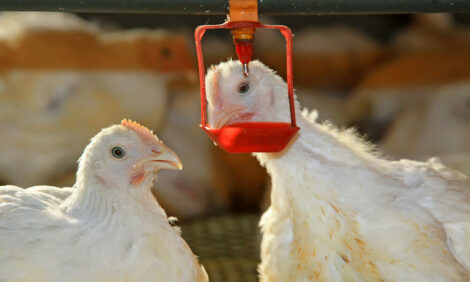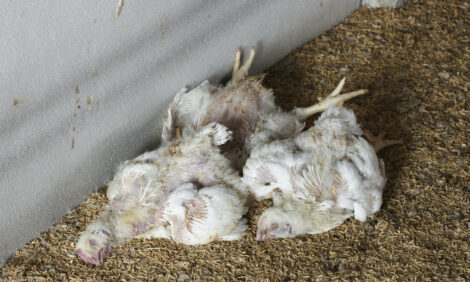



Biosecurity On The Farm Takes On More Importance
US - Biosecurity and the general practice of “agrosecurity” to protect cattle and other livestock has grown in its level of importance in recent years.
Biosecurity has many definitions, but is being defined here as specific ACTIONS a producer can take to reduce the chances of animal diseases or harm to their herd caused by contamination of water, feed, or facilities whether done intentionally or unintentionally.
A smart biosecurity strategy also includes knowing what to do and doing it quickly if something unusual does occur.
In early 2001, the FMD outbreak in the United Kingdom did billions of dollars in economic damage - in some cases, resulting in the destruction of animal bloodlines that had been in families for centuries. In the months that followed Sept. 11, 2001, we discovered that animal agriculture was an industry that terrorists hiding and training in key areas of Afghanistan had in their sights.
All cattle producers need to take the issue of biosecurity seriously, because an event could have massive ripple effects that could touch all parts of our food economy.
Fortunately, there have been few documented cases of intentional “biosecurity” events in the U.S. that have affected cattle. The largest was in Wisconsin in the mid-1990's when a disgruntled worker poisoned several thousand tons of cattle feed with an insecticide, ultimately causing more than a quarter of a billion dollars in economic damage.
But, there have been numerous unintentional events which have occurred such as Bovine TB in several states, anthrax outbreaks in Minnesota and North Dakota, and other diseases which are much more common but that can be controlled through smart biosecurity practices.
Protecting animals from biosecurity threats is not unlike protecting ourselves from illness during “cold and flu” season. You need to be careful where you go (limit external contact), consider the impact of others in your community who might be ill (isolation), and take proper precautions such as washing your hands and staying inside if you're sick (basic hygiene).
Know and trust your source of new animals. Consult with your veterinarian on specifics such as vaccinations and testing. Similar care needs to be taken if you have animals being taken to fairs, shows, or other events where exposure to new pathogens could occur.
Every farm or ranch needs to have a policy and the facilities for handling visitors whether they are sales people, neighbors, or others (like tour groups and school children).
Careful layout of facilities (driveways, parking areas, loading facilities, and delivery routes for supplies) can help minimize the spread of pathogens from off the farm onto your facilities. Of particular concern are people and vehicles/equipment that might be contaminated with manure from other operations. Tires and other contaminated areas on these vehicles need to be cleaned before coming onto your property. This practice is becoming more common in the feed business and for those who haul and apply manure.
Also, do not allow visitors who have been out of the country within the past 10 days. This is especially important as a means to control risk of FMD.
Most ag operations have multiple access points to public roadways. This represents a major biosecurity risk for both intentional and unintentional biosecurity threats.
Make sure areas that are not easily monitored are gated and preferably locked. Pay special attention to any roadway access points where people could have direct access to animals, feed, water, or pesticides.
A smart biosecurity strategy also includes knowing what to do and doing it quickly if something unusual does occur.
In early 2001, the FMD outbreak in the United Kingdom did billions of dollars in economic damage - in some cases, resulting in the destruction of animal bloodlines that had been in families for centuries. In the months that followed Sept. 11, 2001, we discovered that animal agriculture was an industry that terrorists hiding and training in key areas of Afghanistan had in their sights.
All cattle producers need to take the issue of biosecurity seriously, because an event could have massive ripple effects that could touch all parts of our food economy.
Fortunately, there have been few documented cases of intentional “biosecurity” events in the U.S. that have affected cattle. The largest was in Wisconsin in the mid-1990's when a disgruntled worker poisoned several thousand tons of cattle feed with an insecticide, ultimately causing more than a quarter of a billion dollars in economic damage.
But, there have been numerous unintentional events which have occurred such as Bovine TB in several states, anthrax outbreaks in Minnesota and North Dakota, and other diseases which are much more common but that can be controlled through smart biosecurity practices.
Protecting animals from biosecurity threats is not unlike protecting ourselves from illness during “cold and flu” season. You need to be careful where you go (limit external contact), consider the impact of others in your community who might be ill (isolation), and take proper precautions such as washing your hands and staying inside if you're sick (basic hygiene).
Limit external contact
To the extent practical, cattle producers need to understand that bringing outside animals into the herd is an activity that carries a significant level of risk. Ideally, new animals should be isolated and observed for 21-30 days to make sure they are healthy before having contact with other animals. This includes separation of feeding areas, manure, and other areas where direct contact is possible.Know and trust your source of new animals. Consult with your veterinarian on specifics such as vaccinations and testing. Similar care needs to be taken if you have animals being taken to fairs, shows, or other events where exposure to new pathogens could occur.
Manage traffic on your operation
People, vehicles and equipment, and other animals (rodents, birds, and even insects) can spread disease within an operation, or can transfer bacteria, viruses, or other pathogens onto your operation from another contaminated facility.Every farm or ranch needs to have a policy and the facilities for handling visitors whether they are sales people, neighbors, or others (like tour groups and school children).
Careful layout of facilities (driveways, parking areas, loading facilities, and delivery routes for supplies) can help minimize the spread of pathogens from off the farm onto your facilities. Of particular concern are people and vehicles/equipment that might be contaminated with manure from other operations. Tires and other contaminated areas on these vehicles need to be cleaned before coming onto your property. This practice is becoming more common in the feed business and for those who haul and apply manure.
Also, do not allow visitors who have been out of the country within the past 10 days. This is especially important as a means to control risk of FMD.
Most ag operations have multiple access points to public roadways. This represents a major biosecurity risk for both intentional and unintentional biosecurity threats.
Make sure areas that are not easily monitored are gated and preferably locked. Pay special attention to any roadway access points where people could have direct access to animals, feed, water, or pesticides.









